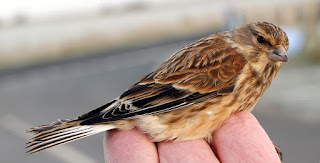Andy and I arranged to meet up at Gulf Lane this morning to test our latest theory about Linnets - we catch better on frosty mornings?
There was a ground frost and a temperature of -1° at 0800.
We had been here on Saturday 4th January and despite a spot count of 400 Linnets we caught a big fat zero, not a single one; the Linnets just weren't interested, this in contrast to 2nd January when we had a catch of twenty-seven. The difference between the two days was - on January 2nd there’s been an overnight frost followed by an icy morning of -2.5°. In total contrast the morning of Saturday 4th January was much warmer at 7°C. My post, Another Bird Blog of 2nd January - “Twenty seven was our best catch of the winter, probably helped by the frosty start and the Linnets’ keenness to eat”.
These are wintering Linnets only, ones which and dependent upon the coming weather, may be back on their way North as early as March. That leaves us just eight or ten weeks to reach our target of 200 new Linnets for the winter period. Another 100 to go.
We set the nets followed by another bucket of millet and rape seed then waited for the Linnet’s arrival. Although the Linnets arrived in good numbers – up to 300, we caught just four. All four were females today. So although it’s back to the drawing board for our next theory, we do not give up so easily and remain convinced that catches will improve.
Linnet - First winter/second calendar year female
Linnet - First winter/second calendar year female
“Ringing has been an important research tool for the conservation biologist over the last 100 years. Effective conservation of wild bird populations requires understanding of bird ecology, the factors driving population change, and evidence that proposed conservation measures can be effective. Bird-ringing studies can provide a wide range of data types to aid and inform this process, and in many cases these data are not available without the capture and marking of individual birds.”
The above is a summary of a paper from Ringing and Migration “The value of ringing for bird conservation”, written in 2009 by Guy Q.A. Anderson and Rhys E. Green.
The full paper, too lengthy to post here, includes sections on:
- Movement between seasons in resident species
- Dispersal Migration routes and strategies
- Survival rates
- Productivity
- Genetic relationship
- How to improve the value of ringing for conservation gain
https://www.researchgate.net/publication/228501270_The_value_of_ringing_for_bird_conservation






























.JPG)







.jpg)












